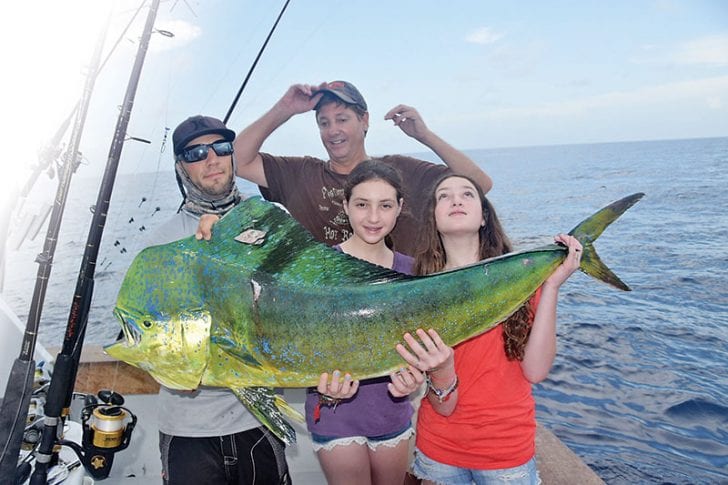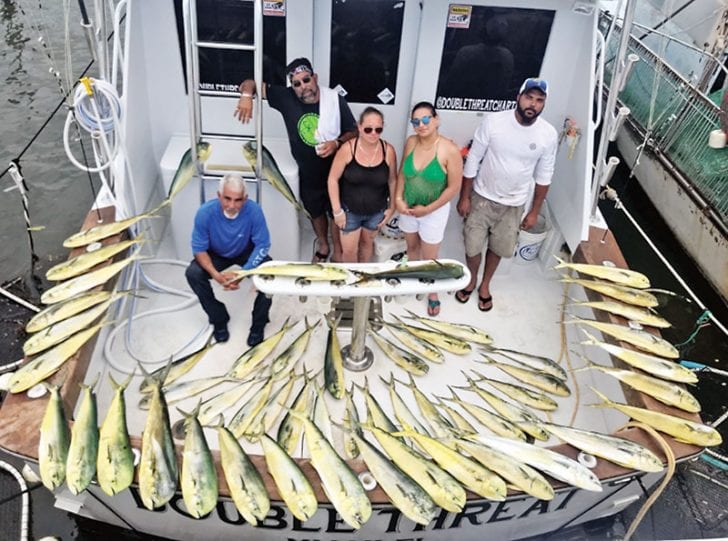
When we post a picture or video catching dolphin, we are instantly messaged, texted and called for reports. Most people have the same question. How far out are the fish? With 50 miles of water between Miami and Bimini, narrowing down where to fish can definitely save time, fuel and effort.
When determining where to focus our efforts there are a handful of variables we take into consideration. The first is the time of year. Dolphin are usually further offshore during warmer months. During June through September, they cruise north in the Gulf Stream while looking for areas with structure for both protection and predation. They look for seaweed, floating debris and and more. During winter we catch many of our dolphin on the edge, closer to shore. There isn’t as much sargassum seaweed during the cooler months so many of the fish are prowling the drop off from 100 to 300 feet where there is usually more bait.
During October and November we actually see some interesting behavior from many pelagic species in the Miami area. During fall, huge schools of ballyhoo and finger mullet make their way along the coast. Ballyhoo usually stay near the reef but during October in particular, they are never safe. This time of year, sailfish, kingfish and even dolphin can be seen “spraying” big schools of ballyhoo in as shallow as 25 feet of water. This is a common occurrence down in the Florida Keys but very seasonal off Miami. If you use live ballyhoo and look for frigate birds on the edge of the reef line, you can often find dolphin in the 50 to 100 foot range chasing bait. The vantage of a tower definitely helps in these situations, but if you get lucky there are few types of fishing more fun than chasing dolphin on the reef.

Aside from the time of year, wind speed and direction is a big factor for determining the best depth to fish for mahi mahi. When looking at the wind it is important to consider conditions on the day you fish in addition to a few days prior to your outing. With little to no wind, weed lines usually start in about 1000 feet of water and you may fish as deep as 2000 feet. If you are fishing after a few days of moderate east wind, the seaweed, floating debris and baitfish may get pushed closer to shore. If this is the case, the fish may be in 800-1100 feet of water. Making a long run is counterproductive on days like this because you may overshoot the most productive areas.
After a big blow with 20 knot plus winds for 3 or more days, the fish are sometimes pushed all the way onto the edge. It’s days like these where quality fish may be caught in 300 to 800 feet of water. If you are fishing on a windy or overcast day, sight fishing can be a bit more difficult. It’s conditions such as these where we may spend more effort looking for birds to help us find the fish. During fall we get some big pushes of northeast wind so it’s not uncommon to find dolphin in shallower water.
If you are fishing after the wind has blown from the west for a few days, the structure as well as the fish may be pushed further out. It’s days like these where 20 plus mile runs are not uncommon. If you find a nice rip it can definitely pay off.
On many days there are multiple weed lines that usually run south to north when its calm or east to west when it is blowing. Trolling parallel to these weed lines is a great way to narrow down productive areas. Always look for bait, birds and any sign of life. If one weed line is barren, push further offshore and work each consecutive line until you find one that is productive. It is important to use binoculars while looking for fish and it also helps to listen to the radio.
CAPT. NICK GONZALEZ
Double Threat Fishing Charters
@DoubleThreatCharters
www.fishmiamicharters.com
(786) 505 8950
info@doublethreatcharters.com

